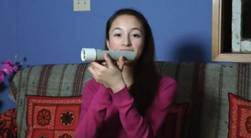A 15-year-old student who invented a flashlight(手电筒) getting power from the holder's body heat is going home today from California with a big prize and a chance to do further research.
Ann Makosinski was the only Canadian among the four winners at Google's international science competition. Thousands of young scientists from around the world took part in the competition.
Winning the science and technology competition was "a surprise". Ann said, "I think it will have a great influence on my future."
Ann thanked her family for encouraging her interest in science and said that her first toy was a box of transistors(晶体管).
Ann's prize includes $ 25,000 and a "once in a-lifetime expericnce" from Google for her Hollow Flashlight, which has no moving parts or batteries.
The idea for the invention came from seeing unwanted batteries and her friend's experience. When Ann visited a friend in the Philippines, she saw the friend couldn't study when it became dark because there was no electricity or light. She saw the need for a flashlight that has no batteries - Hollow Flashlight.
In her project, Ann wrote "I made two flashlights that do not use any batteries or harmful materials. They do not create any noise and will always work. The flashlight needs at least a 5℃ temperature difference between the holder's body and the environment around to produce light."
A video of Ann explaining how she creatcd the flashlight has been watched more than 1.4 million times on the Internet.
Though Ann was successful, she has not made a decision about her career path. Ann hopes that she can find a way to join her love of film and science together.
The four winners were chosen from 15 final competitors from eight countries. The competition attracted thousands of students in 120 countries.

小题1:In which part of a newspaper can we probably read this passage?
A.Travel.
B.Culture.
C.Technology.
D.Advertisement.小题2: The first paragraph is written to be a(n) ________.
A.introduction
B.warning
C.argument
D.discussion小题3:Paragraph 6 mainly tells us ________.
A.what Ann saw in the Philippines
B.why Ann invented Hollow Flashlight
C.how Ann's family encouraged her interest
D.what prize Ann got for Hollow Flashlight小题4:According to the passage, we learn ________.
A.easy to win the international science competition
B.Hollow Flashlight is safe, noiseless and can save energy
C.Ann has made a decision to be a scientist in the future
D.few people are interested in how Ann created the flashlight
小题1:C
小题2:A
小题3:B
小题4:B
题目分析:15 岁的学生Ann Makosinski发明了用持有者的身体热量作为电源的手电筒。今天从加州拿着$ 25,000的大奖回家,还获得了一个进一步研究的机会。这个发明的想法是从看到不需要的电池和她的朋友的经历中想到的。Hollow Flashlight环保、安全、无噪音。
小题1:细节理解题。根据第一段介绍发明手电筒可知这篇文章应该在报纸的科学技术栏。Travel旅游; Culture文化;Technology技术;Advertisement广告。故选C。
小题2:推理判断题。A. introduction介绍;B. warning预告;C. argument争论;D. discussion讨论。根据第一段的内容(一个 15 岁的学生发明了从持有者的身体热量获得电源的手电筒。今天从加州拿着大奖回家,还获得了一个进一步研究的机会。)可知,故选A。
小题3:段落归纳题。根据第6段的意思可知,这个发明的想法是从看到不需要的电池和她的朋友的经历中想到的。当安在菲律宾去拜访朋友时,她看到朋友无法学习当天暗下来,因为没有电也没有光。她看到对不用电池-空心手电筒的需要。故选B(Ann为什么发明中空手电筒)。
小题4:推理判断题。根据I made two flashlights that do not use any batteries or harmful materials. They do not create any noise and will always work.可知,Hollow Flashlight环保、安全、无噪音。故选B。
